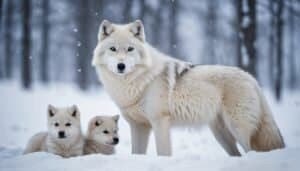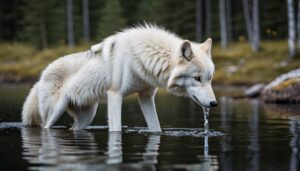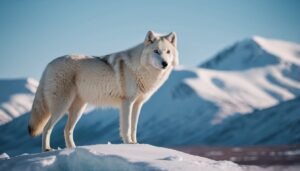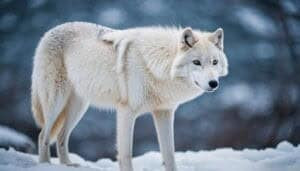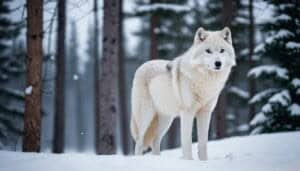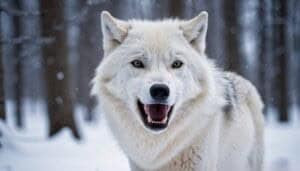Introduction
The Arctic wolf, a remarkable predator of the tundra, has evolved several adaptations to thrive in its harsh, frigid environment. This article explores the various ways Arctic wolves regulate their body temperature, covering physical adaptations, the role of their fur, behavioral strategies, and dietary contributions
We will also delve into how these wolves cope with extreme cold, maintain body heat during activity, and the development of thermoregulation in young wolves. Join us as we uncover the secrets behind the Arctic wolf’s ability to endure one of the most extreme climates on Earth
Adaptations for Temperature Regulation in Arctic Wolves
Arctic wolves are incredibly well-adapted to their frigid environment, utilizing a range of physical, behavioral, and dietary strategies to maintain their body temperature. Understanding these adaptations offers insight into how they thrive in one of the harshest climates on Earth
Physical Adaptations
Arctic wolves have several physical features that help them conserve heat and survive the extreme cold. Their bodies are stocky and compact, minimizing the surface area exposed to the cold and reducing heat loss. Shorter ears and muzzle compared to other wolf species also help to prevent frostbite and conserve body heat
Additionally, their paws are equipped with thick pads and fur, which act as natural insulators against the icy ground
Role of Fur in Temperature Control
The Arctic wolf’s fur is perhaps its most critical adaptation for temperature regulation. They have a dense undercoat that provides insulation, trapping warm air close to their bodies. Over this undercoat, a layer of longer guard hairs helps to repel snow and water, keeping the underlayer dry
During the winter, their fur becomes even thicker and longer, providing extra protection against the cold. In contrast, during the summer months, they shed much of this fur to prevent overheating
Behavioral Strategies for Staying Warm
Beyond physical adaptations, Arctic wolves employ several behavioral strategies to stay warm. They are known to huddle together in packs, which conserves body heat and offers mutual warmth
When resting, they curl up tightly, covering their noses with their tails to keep them warm and reduce heat loss. These wolves are also active during the warmer parts of the day, minimizing exposure to the coldest temperatures
Influence of Body Size on Heat Retention
The Arctic wolf’s body size plays a significant role in its ability to retain heat. Generally, larger animals lose heat more slowly than smaller ones because they have a lower surface area-to-volume ratio
This principle is known as Bergmann’s rule, which states that animal species in colder climates tend to have larger body sizes. Arctic wolves exemplify this rule, with their robust build helping them to conserve heat effectively
Adaptations in Body Shape
In addition to size, the shape of an Arctic wolf’s body helps with temperature regulation. Their stocky build and shorter extremities reduce the amount of exposed surface area, which is critical for conserving heat
This compact body shape is a common adaptation among animals living in polar environments, helping them to endure the extreme cold
Nutritional Contributions to Body Heat
Diet also plays a crucial role in the Arctic wolf’s ability to regulate its body temperature. Their diet consists mainly of high-fat and high-protein prey such as musk oxen and Arctic hares, which provide the necessary energy to generate body heat
The metabolic process of digesting these nutrient-dense foods produces significant internal heat, aiding in thermoregulation
Hunting and Feeding Patterns
Arctic wolves have adapted their hunting and feeding patterns to maximize energy intake and minimize energy expenditure. They often hunt in packs, which increases their efficiency and success rate, ensuring a steady supply of food even in the harshest conditions
During lean times, they can go without food for extended periods, relying on their fat reserves to maintain body heat and energy levels
Coping with Extreme Cold
Arctic wolves are masters of survival in the severe cold of their habitat. Their ability to cope with such extreme conditions is a testament to their evolutionary adaptations, which include both physical and physiological mechanisms
Survival Tactics in Winter
During the harsh winter months, Arctic wolves employ several tactics to ensure their survival. One key strategy is their pack behavior. By living and hunting in packs, they can take down larger prey that provide ample food for the entire group, ensuring they have the energy needed to generate body heat. Additionally, the pack structure allows them to share warmth during rest periods, reducing individual energy expenditure
Arctic wolves are also known to use natural shelters to protect themselves from the wind and cold. They seek out caves, dense vegetation, or even dig into the snow to create insulated dens. These shelters provide a critical barrier against the elements, helping them to conserve heat
Physiological Mechanisms
On a physiological level, Arctic wolves have several mechanisms that support their thermoregulation. One such mechanism is their efficient circulatory system. Blood flow is directed towards the core of the body to maintain vital organ function, while the extremities receive less blood flow, reducing heat loss. This process is known as peripheral vasoconstriction
Moreover, Arctic wolves have a high metabolic rate, which generates significant internal heat. This high metabolism is sustained by their rich diet of fatty and protein-rich foods. The process of metabolizing these nutrients produces heat, which helps to maintain their body temperature even in freezing conditions
Impact of Climate and Weather
The Arctic climate poses constant challenges for temperature regulation. The extreme variability in weather conditions requires the wolves to be highly adaptable. For instance, during blizzards or severe cold snaps, Arctic wolves may reduce their activity levels to conserve energy and minimize exposure to the elements. Conversely, during milder conditions, they become more active, taking advantage of the relative warmth to hunt and replenish their energy reserves
Adaptations to Environmental Changes
As the Arctic environment undergoes changes due to climate change, Arctic wolves face new challenges in temperature regulation. Warmer temperatures can lead to the melting of permafrost and changes in prey availability, which can impact their ability to maintain their body heat
However, Arctic wolves have shown a remarkable capacity to adapt to these changes. They adjust their hunting patterns, diet, and even their migratory behavior in response to shifting environmental conditions
Arctic wolves also demonstrate a high degree of plasticity in their physiological responses. This adaptability is crucial for their survival as they navigate the increasingly unpredictable Arctic climate. Despite these challenges, Arctic wolves continue to thrive, showcasing their resilience and adaptability in one of the planet’s most extreme environments
Thermoregulation During Physical Activity
Physical activity plays a significant role in the Arctic wolf’s ability to regulate its body temperature. Their active lifestyle, which includes hunting, traveling, and playing, helps them generate and maintain body heat in their frigid environment
Heat Production Through Movement
When Arctic wolves are active, their muscles produce heat through metabolic processes. This internal heat generation is crucial for maintaining their core temperature, especially during cold weather. Activities like running, chasing prey, and digging help to raise their body temperature. The increase in blood circulation during physical activity also helps distribute warmth throughout their bodies
Hunting, in particular, is a vital activity that not only provides food but also generates significant body heat. Wolves often hunt in packs, engaging in high-energy pursuits that keep them warm. The collaborative nature of their hunts means they can sustain longer periods of activity, which is essential for maintaining body heat during extended cold periods
Balancing Activity and Rest
While physical activity is essential for generating heat, Arctic wolves also need to balance this with rest to avoid exhaustion and conserve energy. After periods of intense activity, such as a hunt, wolves will rest to recover and maintain their energy levels. During these rest periods, they often huddle together for warmth, further conserving body heat
Arctic wolves are strategic about their activity levels, often increasing their activity during the warmer parts of the day and reducing it during the coldest times. This behavior helps them maximize heat production when it’s most needed and minimize energy loss when it’s coldest
Additionally, their ability to slow down their metabolism during periods of inactivity helps them conserve energy and maintain body heat without expending too many resources
This balance of activity and rest is crucial for their survival, as it allows them to stay warm and conserve energy, ensuring they can sustain themselves in the long term. The combination of physical activity and strategic rest periods is a key component of the Arctic wolf’s thermoregulation strategy, helping them thrive in their icy habitat
Development of Thermoregulation in Young Arctic Wolves
Young Arctic wolves, or pups, must develop effective thermoregulation abilities to survive in their harsh environment. This development involves a combination of growth processes and learning from adult wolves
Growth and Adaptation Phases
Arctic wolf pups are born in the spring, when the weather is milder, giving them time to grow and develop before facing the harsh winter conditions. At birth, pups are blind, deaf, and have short, thin fur, making them vulnerable to the cold. During the first few weeks of life, they rely heavily on their mother and the warmth of the den for survival
As they grow, their fur thickens, providing better insulation against the cold. By the time they are ready to leave the den, they have developed a dense undercoat and guard hairs similar to adult wolves. This growth phase is crucial as it prepares them physically to handle the dropping temperatures
Learning from Adult Wolves
Young Arctic wolves learn essential survival and thermoregulation techniques from observing and interacting with adult wolves. This includes understanding how to seek shelter, conserve energy, and huddle together for warmth. The social structure of the pack provides a supportive environment for pups to learn these behaviors
Adult wolves also teach pups about hunting and feeding patterns, which are vital for maintaining energy levels and body heat. By participating in pack hunts, pups learn to generate heat through physical activity and understand the importance of a high-fat diet for thermoregulation
The pack’s protective and nurturing behavior ensures that pups receive the necessary care and guidance during their early months. This period of learning and adaptation is critical for their survival and ability to thrive in the Arctic environment
The development of thermoregulation in young Arctic wolves is a gradual process that combines physical growth with learned behaviors. Through their interactions with adult wolves and exposure to their environment, pups gain the skills and adaptations needed to regulate their body temperature effectively. This comprehensive development process ensures that by the time they are independent, young wolves are well-equipped to face the challenges of their frigid habitat
Conclusion
The Arctic wolf’s ability to regulate its body temperature is a fascinating testament to its evolutionary adaptations. These wolves have developed an array of physical, behavioral, and physiological strategies to endure the extreme cold of their habitat
Their dense fur, compact body shape, and high-fat diet are critical physical adaptations that help retain body heat. Behavioral strategies, such as huddling together and adjusting activity levels, further aid in maintaining warmth
Additionally, the Arctic wolf’s coping mechanisms during the harsh winter months include utilizing shelters, strategic hunting, and reducing activity to conserve energy. Their physiological adaptations, such as efficient blood circulation and a high metabolic rate, play a crucial role in generating and conserving heat
The development of thermoregulation in young wolves, guided by growth and learning from adults, ensures that new generations are well-prepared to survive in their icy environment
Overall, the Arctic wolf’s remarkable ability to regulate its body temperature showcases its resilience and adaptability, enabling it to thrive in one of the most challenging climates on Earth



